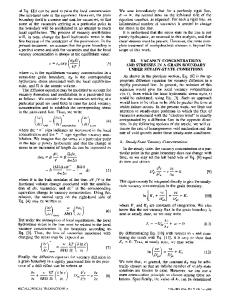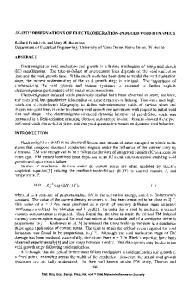Effect of Stresses on Void Nucleation During Electromigration
- PDF / 980,532 Bytes
- 6 Pages / 420.48 x 639 pts Page_size
- 31 Downloads / 381 Views
EFFEC'i OF STRESSES ON VOID NUCLEATION DURING ELECTROMIGRATION F. R. Brotzen*, C. T. Rosenmayer**, C. F. Dunn*** and J. W. McPherson*** *Rice University, Department of Materials Science, Houston, TX 77251-1892 **IBM, Austin, Tx 78758
"*** Texas Instruments, Inc., Dallas Tx 75265-655012 ABSTRACT Based on experimental findings obtained earlier by the authors [1], a model is devised in which the divergence of the vacancy flow created in the grain boundaries of Al-Si(l%) metallizations by high-density DC is attributed to temperature gradients and structural features. Void nuclei of critical size are created in areas of high vacancy concentration. These nuclei grow, fed by the electromigrational vacancy current. It is shown that stresses have only a negligible' effect on the vacancy diffusion but influence the nucleation process dramatically. Results* expressed in terms of fraction of void area are calculated and then correlated with experimental results. Certain material parameters, whose values are not known, are derived from the experimental data. The physical significance of these parameters is discussed.
INTRODUCTION By promoting the formation of voids and hillocks in thin-film metallizations, mechanical stresses create an adverse effect on the reliability of microcircuits [2,3]. The physical processes that cause the enhancement of electromigrational defects are not yet fully understood. Reliabilty is generally expressed in terms of the MTF (Median Time of Failure in a standardized test), and most quantitative studies have been aimed at the prediction of this MTF [4-8]. The generation of stresses as a result of electromigrational defect formation in thin-film metallizations was recently treated in a novel way by Kirchheim [9]. The present study has been carried out with the expectation of shedding some light on the connection between stresses and defect formation under conditions of electromigration. It deals exclusively with the treatment of voids and disregards the formation of hillocks. To this end, a mathematical model was developed based on vacancy diffusion in the grain boundaries and on the nucleation of voids, taking into account the effects of stresses, temperature distributions and current densities. The calculations were correlated with experimental results. The latter had been obtained earlier by the authors [1] and were utilized here to provide values for certain physical parameters. In developing the mathematical model, special attention was given to the effect of stresses which may affect the creation and growth of defects, such as voids, in any of the following ways: (1) Stress gradients may enhance self diffusion; (2) Stresses may reduce the formation energy of point defects; (3) Stresses in the plastic regime would lead to point-defect formation; (4) Stresses influence the critical size of void nuclei, which form by agglomeration of vacancies. Results obtained here point to the particularly important role that tensile stresses play in the nucleation of voids (item 4 above), while they seem to ha
Data Loading...











